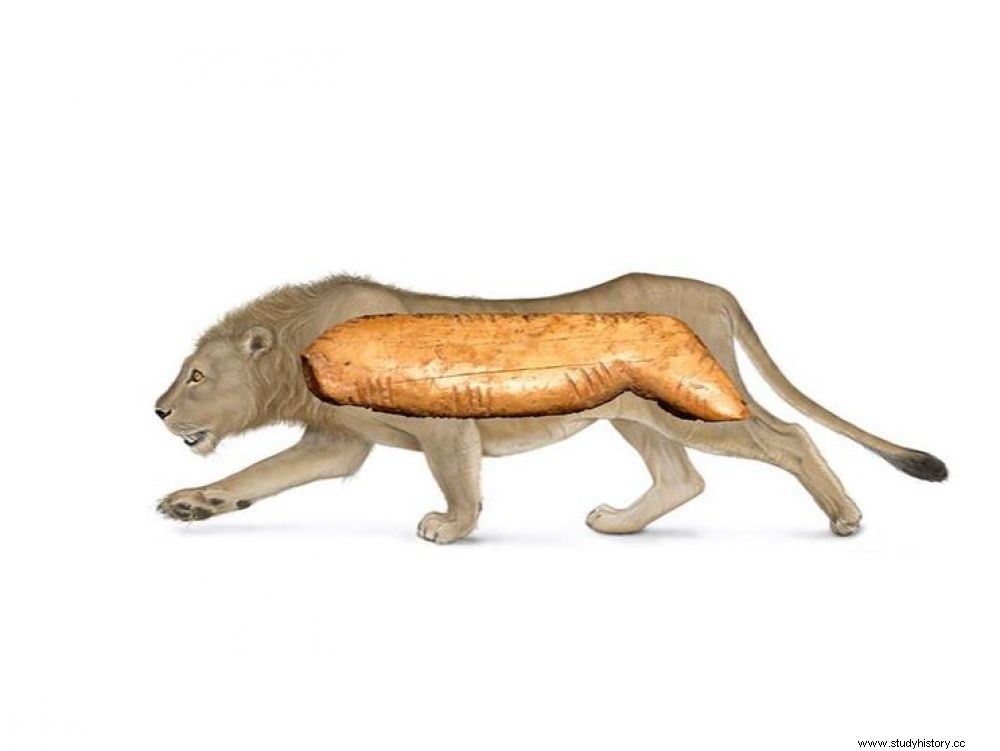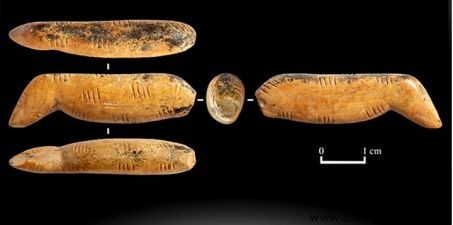In the Altai Mountains in southern Siberia, prehistorians have discovered the remains of a 45,000-year-old lion figurine, perhaps the oldest in the world.

Lion figurine fragment discovered in level 11 of Denisova Cave, Altai, Siberia (Russia).
A chest with a dress decorated with hatching colored with red ocher, the start of a powerful hock... Although incomplete, it is an exceptional vestige of portable art representing a cave lion (Panthera spelaea) 45,000 years old that archaeologists have just unearthed in the Denisova cave in Siberia. Carved from woolly mammoth ivory, the delicate miniature, 4.2cm long and 8mm thick, was unearthed in September 2019 in northern Altai by teams from the Institute of archeology and ethnography of Novossisbirk, as reported by the daily Siberian Times from November 20, 2019.

The head has been lost, but you can clearly recognize the long body of a feline, and the start of a hind leg, on this figurine carved from woolly mammoth ivory. © Siberian Times

Different views of the lion figurine. © Siberian Times
The Denisova site has become famous since the discovery in 2010 of a fossil phalanx of "juvenile" - the little finger of a girl -, having lived 41,000 years ago and whose mitochondrial DNA analysis indicated that it belonged to a human species hitherto unknown. Named Denisova, these distant cousins lived in the Altai Mountains in Central Asia at the same time as Neanderthals and our Homo sapiens ancestors.
A chest with a dress decorated with hatching colored with red ocher, the start of a powerful hock... Although incomplete, it is an exceptional vestige of portable art representing a cave lion (Panthera spelaea) 45,000 years old that archaeologists have just unearthed in the Denisova cave in Siberia. Carved from woolly mammoth ivory, the delicate miniature, 4.2cm long and 8mm thick, was unearthed in September 2019 in northern Altai by teams from the Institute of archeology and ethnography of Novossisbirk, as reported by the daily Siberian Times from November 20, 2019.

The head has been lost, but you can clearly recognize the long body of a feline, and the start of a hind leg, on this figurine carved from woolly mammoth ivory. © Siberian Times

Different views of the lion figurine. © Siberian Times
The Denisova site has become famous since the discovery in 2010 of a fossil phalanx of "juvenile" - the little finger of a girl -, having lived 41,000 years ago and whose mitochondrial DNA analysis indicated that it belonged to a human species hitherto unknown. Named Denisova, these distant cousins lived in the Altai Mountains in Central Asia at the same time as Neanderthals and our Homo sapiens ancestors.

Entrance to the prehistoric cave of Denisova (Russia). © Siberian Times
Nevertheless, although the Denisova cavity is one of the most studied prehistoric sites, it is not clear at the moment to know to whom this work is attributed. That is to say, whether this lion was shaped by Denisovans, or even modern man. At 45,000 years old, if confirmed, this Denisova lion could… even be the oldest animal figure in the world.

Panel of Lions, adorning the walls of the Chauvet cave, in Ardèche. Parietal works of art dated 37,000 years. © Christophe Lepetit/ only France / AFP
Felines of which we see more and more the importance that this animal seems to have exercised in the symbolic thought of men of the Upper Paleolithic, like the extraordinary frescoes of lionesses adorning the walls of the Chauvet cave, in Ardèche (37,000 years old); or cave lion sanctuaries encountered in the Urals (Russia); as well as statuettes of a man with a lion's head from 30,000 to 40,000 years old also carved in mammoth ivory unearthed in 1939 in the cave of Hohlenstein-Stadel (Baden-Württemberg), and more recently in that of Hohle Fels, in 2002, in this same region of the Swabian Jura (Germany). The lion king of beasts for millennia?
The cave lion (taken from an article in Sciences et Avenir published in September 2015)
"The cave lion was present throughout Eurasia from 300,000 years ago to about 11,000 years ago. However, there is still no consensus on the phylogeny of the feline. Some believe that the cave lion belongs to the same species than that currently found in Africa. Others do not. However, Panthera leo fossilis , the archaic lion, is considered to be the first representative of the genus Panthera leo . The oldest known specimens were found from the Middle Pleistocene (between 800,000 and 200,000 years ago) in Italy, England and Germany. Its Late Pleistocene successor, Panthera leo spelea , would have appeared a little more than 100,000 years ago. The last individuals belonging to this species were described in southern Europe around 10,500 years ago".
